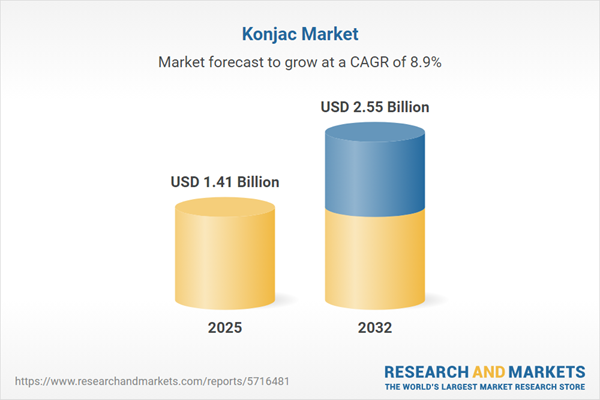Speak directly to the analyst to clarify any post sales queries you may have.
Konjac is positioning itself as a valuable asset for organizations seeking to strengthen sustainable sourcing, operational efficiency, and product innovation. This market’s continued evolution is prompting industry leaders to consider konjac integration as a proactive approach to meeting shifting business requirements and stakeholder expectations.
Konjac Market Snapshot
The global konjac market is showing consistent growth momentum, with a projected valuation of USD 1.41 billion in 2025 and a compound annual growth rate (CAGR) of 8.87% from 2024. This expansion is closely aligned with rising industry adoption of plant-based alternatives, as well as continuous advancements in extraction and processing technologies. Applications in food, pharmaceuticals, and personal care are broadening, reinforcing konjac’s multifaceted role in portfolios focused on innovation, resilience, and adaptability. By utilizing konjac, businesses are achieving greater supply chain stability and supporting compliance within sustainable business models.
Scope & Segmentation: Strategic Intelligence in the Konjac Market
Designed for executives overseeing procurement, operations, and supply chain management, this report provides actionable insights into the evolving konjac landscape. Understanding segmentation is critical for decision-makers who must align investment, compliance, and innovation with market realities and consumer expectations. The report highlights core market segments and their impact on growth strategies across industries.
- Form: Chips, granules, gum, and powder support customization in food manufacturing, personal care development, and various industrial processes.
- Application: Functions as a stabilizer and thickener in food products, a primary component in skin and hair care, and an essential ingredient in pharmaceutical manufacturing.
- Distribution Channel: Direct sales, supplier networks, and digital procurement channels provide multiple avenues for responsive and efficient sourcing across the B2B landscape.
- End User Industry: Facilitates innovation and agility within animal feed, food processing, personal care, and pharmaceutical sectors.
- Region: Variations in regulatory environments and supply structures in the Americas, Europe, Middle East & Africa, and Asia-Pacific require region-specific investment and compliance approaches.
- Key Companies: Hubei Shiyuan Konjac Food Co., Ltd., Shandong Konmax Biomass Technology Co., Ltd., Konjac Bio-Tech (Thailand) Co., Ltd., and Zhejiang Jinhua Konjac Technology Co., Ltd. are shaping technological and industry standards.
Tariff Impact: Strategic Considerations for Cost and Sourcing
Amendments to U.S. tariffs are affecting global konjac sourcing strategies. Companies are expanding their supplier bases, exploring domestic processing options, and establishing strategic alliances to ensure continuity. These initiatives support flexible supply chain models capable of withstanding economic and geopolitical changes while maintaining service commitments.
Key Takeaways for Senior Decision-Makers
- Versatile properties of konjac foster portfolio diversification and expand opportunities in food, personal care, and pharmaceutical segments in response to changing consumer and regulatory trends.
- Plant-based and clean-label attributes of konjac support responsible sourcing, allowing for transparent operations and improved alignment with international compliance standards.
- Continual advancements in extraction and processing technologies enable manufacturers to streamline operations, increase product versatility, and explore new commercial applications.
- Integrated supply management methods help organizations build resilience, proactively address disruptions, and fortify long-term business risk mitigation strategies.
- Localized approaches that account for varying regional regulatory requirements ensure compliance and unlock growth within targeted markets.
Methodology & Data Sources
This analysis draws from primary research with direct stakeholder engagement across the konjac value chain. Additional validation relies on the latest regulatory documents and comprehensive trade data to deliver credible and actionable guidance for executive audiences.
Why This Konjac Market Report Matters
- Equips procurement and compliance teams with strategies to promote supply chain consistency and robust risk management as market conditions transition.
- Provides clear frameworks for navigating complex market dynamics, supporting quick and informed strategic decisions for competitive positioning.
- Enables organizations to enhance agility and adaptability within shifting global and regional business environments.
Conclusion
Staying ahead in the konjac market allows companies to capture emerging opportunities and raise operational benchmarks. Leveraging timely market intelligence will be essential as industry goals and stakeholder demands evolve.
Additional Product Information:
- Purchase of this report includes 1 year online access with quarterly updates.
- This report can be updated on request. Please contact our Customer Experience team using the Ask a Question widget on our website.
Table of Contents
3. Executive Summary
4. Market Overview
7. Cumulative Impact of Artificial Intelligence 2025
Companies Mentioned
The companies profiled in this Konjac market report include:- Hubei Shiyuan Konjac Food Co., Ltd.
- Shandong Konmax Biomass Technology Co., Ltd.
- Konjac Bio-Tech (Thailand) Co., Ltd.
- Zhejiang Jinhua Konjac Technology Co., Ltd.
- LKL International Natural Products Inc.
- Good Friend Biochemical Pharmaceutical Co., Ltd.
- Meihua Holdings Group Co., Ltd.
- NutraKonjac Co., Ltd.
- Tasel Konjac Products Co., Ltd.
- Guangzhou Perfect Konjac Food Technology Co., Ltd.
Table Information
| Report Attribute | Details |
|---|---|
| No. of Pages | 184 |
| Published | October 2025 |
| Forecast Period | 2025 - 2032 |
| Estimated Market Value ( USD | $ 1.41 Billion |
| Forecasted Market Value ( USD | $ 2.55 Billion |
| Compound Annual Growth Rate | 8.8% |
| Regions Covered | Global |
| No. of Companies Mentioned | 11 |









